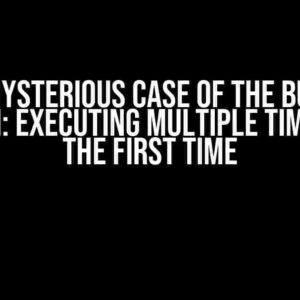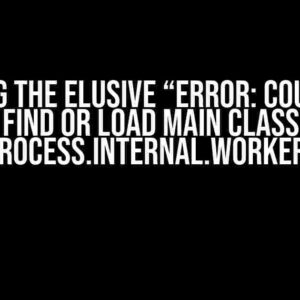Are you tired of dealing with mysterious browser event blocking issues in your Next.js application? You’re not alone! In this article, we’ll dive into the world of browser events, explore the common issue of event blocking by third-party applications, and provide a step-by-step guide on how to detect and mitigate these issues in your Next.js application (version 13).
What are Browser Events?
Browsers events are actions triggered by user interactions, such as clicking, scrolling, or hovering over an element. These events are crucial for creating interactive and engaging web experiences. Some common browser events include:
- Blur: Occurs when an element loses focus.
- Focus: Occurs when an element gains focus.
- Visibilitychange: Occurs when the visibility of a tab or window changes.
- Resize: Occurs when the browser window is resized.
- Scroll: Occurs when the user scrolls the page.
The Problem: Third-Party Application Event Blocking
Sometimes, third-party applications installed on a user’s browser can interfere with your application’s functionality by blocking or hijacking browser events. This can lead to broken or unexpected behavior in your application. For instance:
- A popular ad blocker might prevent your app from detecting scroll events, causing issues with infinite scrolling or lazy loading.
- A browser extension might capture focus events, making it difficult for users to interact with your app’s input fields.
- A productivity tool might block visibilitychange events, preventing your app from responding to changes in tab or window visibility.
Detecting Browser Event Blocking in Next.js (Version 13)
To detect browser event blocking in your Next.js application, you’ll need to:
- Listen for browser events using event listeners.
- Monitor event listener behavior and detect potential blocking issues.
- Analyze and debug the issue to identify the culprit (third-party application).
Step 1: Listen for Browser Events using Event Listeners
In your Next.js application, create a new file (e.g., `event-listeners.js`) and add the following code:
import { useEffect } from 'react';
const eventListeners = () => {
useEffect(() => {
const handleBlur = () => {
console.log('Blur event triggered!');
};
const handleVisibilityChange = () => {
console.log('Visibility change event triggered!');
};
document.addEventListener('visibilitychange', handleVisibilityChange);
document.addEventListener('blur', handleBlur);
return () => {
document.removeEventListener('visibilitychange', handleVisibilityChange);
document.removeEventListener('blur', handleBlur);
};
}, []);
};
export default eventListeners;
In this example, we’re using the `useEffect` hook to add event listeners for `blur` and `visibilitychange` events. When these events are triggered, the corresponding functions will be executed, logging a message to the console.
Step 2: Monitor Event Listener Behavior and Detect Potential Blocking Issues
To detect potential blocking issues, you’ll need to monitor the event listener behavior and look for inconsistencies or unexpected behavior. For instance:
const eventMonitor = () => {
useEffect(() => {
let blurCount = 0;
let visibilityChangeCount = 0;
const handleBlur = () => {
blurCount++;
console.log(`Blur event triggered! (Count: ${blurCount})`);
};
const handleVisibilityChange = () => {
visibilityChangeCount++;
console.log(`Visibility change event triggered! (Count: ${visibilityChangeCount})`);
};
document.addEventListener('visibilitychange', handleVisibilityChange);
document.addEventListener('blur', handleBlur);
return () => {
document.removeEventListener('visibilitychange', handleVisibilityChange);
document.removeEventListener('blur', handleBlur);
};
}, []);
// Analyze the event counts to detect potential blocking issues
if (blurCount === 0 || visibilityChangeCount === 0) {
console.log('Potential event blocking issue detected!');
}
};
export default eventMonitor;
In this example, we’re monitoring the event counts and detecting potential blocking issues by checking if the event counts are zero. If an issue is detected, a message will be logged to the console.
Step 3: Analyze and Debug the Issue to Identify the Culprit (Third-Party Application)
Once you’ve detected a potential blocking issue, it’s essential to analyze and debug the problem to identify the culprit (third-party application). You can use various debugging techniques, such as:
- Browser DevTools: Inspect the event listeners and debug the application using the browser’s DevTools.
- Console Logging: Log messages to the console to track the event listener behavior and identify patterns.
- Debugging Libraries: Utilize debugging libraries like React DevTools or Redux DevTools to gain deeper insights into your application’s state and behavior.
By following these steps, you’ll be able to detect browser event blocking issues caused by third-party applications in your Next.js application (version 13).
Mitigating Browser Event Blocking Issues
Once you’ve identified the culprit, you can take steps to mitigate the issue:
- Notify users: Inform users about the potential issue and provide guidance on how to resolve it (e.g., disabling the problematic extension).
- Workaround: Implement workarounds or fallbacks to ensure your application remains functional even when events are blocked.
- Collaboration: Collaborate with the third-party application developers to resolve the issue or provide a solution.
| Issue Type | Mitigation Strategy |
|---|---|
| Ad blocker blocking scroll events | Implement lazy loading or infinite scrolling workarounds. |
| Browsers extension capturing focus events | Use a fallback input field or provide alternative input methods. |
| Productivity tool blocking visibilitychange events | Implement a visibility change detection mechanism using alternative methods (e.g., window focus or blur events). |
By detecting and mitigating browser event blocking issues, you can ensure a seamless and engaging user experience in your Next.js application, even in the presence of third-party applications.
Conclusion
Detecting browser event blocking by third-party applications in Next.js (version 13) requires a combination of event listener monitoring, issue detection, and mitigation strategies. By following the steps outlined in this article, you’ll be well-equipped to handle these issues and provide a robust and user-friendly experience for your application’s users.
Remember, a robust application is one that can adapt to the complexities of the web and provide a seamless experience for users, even in the face of third-party application interference.
Frequently Asked Question
Get the scoop on detecting browser events blocked by third-party applications in Next.js version 13!
What browser events can be blocked by third-party applications in Next.js?
In Next.js version 13, third-party applications can block browser events such as blur, visibilitychange, resize, and scroll. These events are crucial for enabling features like auto-logout when a user switches tabs or minimizes the browser window.
How do I detect browser event blocking by third-party applications in Next.js?
You can detect browser event blocking by using the `addEventListener` method and checking if the event listener is actually added to the browser. If the event listener is not added, it’s likely that a third-party application is blocking the event.
Why is it important to detect browser event blocking in Next.js?
Detecting browser event blocking is crucial for maintaining the security and integrity of your Next.js application. If a third-party application blocks events like blur or visibilitychange, your app may not be able to log out users automatically, leading to security vulnerabilities.
Can I use a library to detect browser event blocking in Next.js?
Yes, you can use libraries like `Visibility` or `blur-event-polyfill` to detect browser event blocking in Next.js. These libraries provide a simple way to detect when events are being blocked and allow you to take alternative actions.
What are some common third-party applications that block browser events in Next.js?
Some common third-party applications that block browser events in Next.js include ad blockers, browser extensions, and VPNs. These applications may block events to protect user privacy, but they can also interfere with the functionality of your Next.js application.



